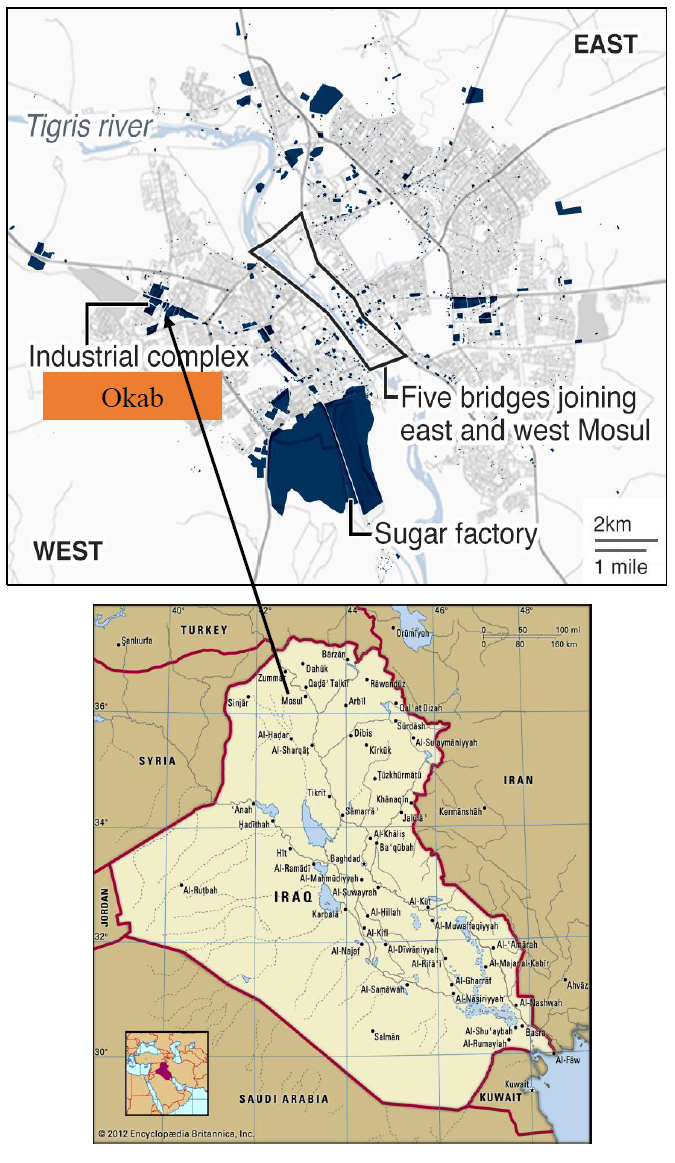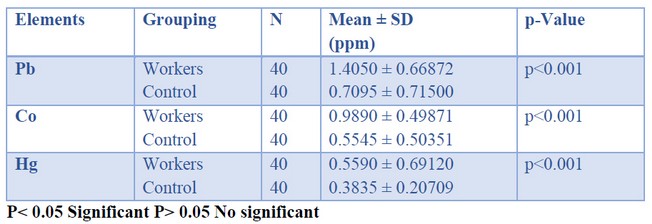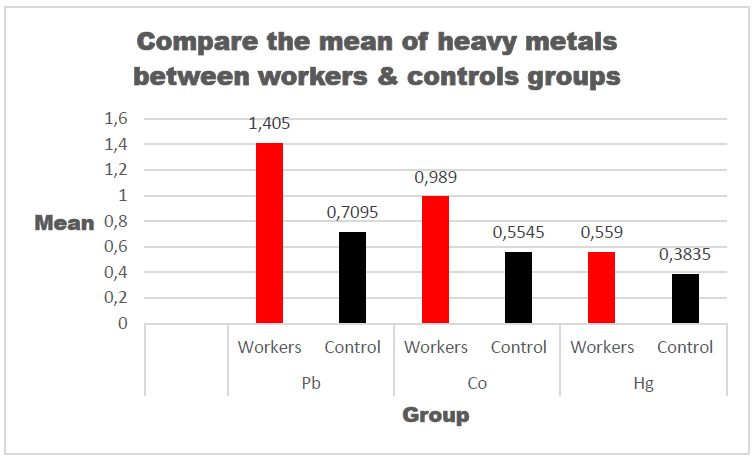2021.06.03.16
Files > Volume 6 > Vol 6 No 3 2021
INVESTIGATION / RESEARCH
Investigate workers' health in the western industrial region, Mosul, Iraq
Salim Rabeea Znad 1 Mazin Nazar Fadhel 2, Ayça Erdem Ünşar 3,
Available from: http://dx.doi.org/10.21931/RB/2021.06.03.16
ABSTRACT
The current study aims to determine the level of heavy metal contamination in the Western Industrial Region of Mosul City, northern Iraq. Heavy metals such as( Pb ،Co ،Hg ) are measured In the blood serum of 40 workers in the main industrial areas of Mosul City. It was compared with the control group of (40) people from Mosul university, Where is Far away from the industrial areas and all activities.
The results indicated a highly significant increase of P<0.001 in the serum of the workers in the industrial areas compared with the control group. The study investigates the impact of heavy metals on the workers' health in the industrial areas who are in direct contact with them.
Keywords: investigation, Heavy metals Pollution, Blood Serum, industrial Region.
INTRODUCTION
Industry areas are often associated with positive economic benefits such as job creation and increased standard of living; however, Industrial activities may also negatively impact the environment and human health. Industrial activities are dangerous to human health, as heavy metals, mainly Hg, Pb, and Cobalt (Co), are often released into the environment1.
Metals such as lead (Pb), Cobalt (Co), mercury (Hg) are unknown Function in the environment 2.
These metals are quickly released into the environment via anthropogenic activities, e.g., metal plating facilities, mining, and agricultural activities3.
Some of these metals are known to act as human mutagens and carcinogens and are associated with various human ailments such as cardiovascular, nervous system, blood and bone diseases, kidney failure, gingivitis, and tremors, among others4.
Mercury (Hg) is present in the Earth's crust. Although present in the environment and atmosphere in small quantities, it is release through anthropogenic emissions. Mercury toxicity is not limited to humans; it is also toxicity to animals and plants5.
Natural sources of mercury in the environment include mercury vapor from volcanoes and forest fires. More recent anthropogenic sources include burning coal and fossil fuels, mining mercury, precious metal refinement, electrical and automotive part manufacture, chemical processing, and release through waste incineration, landfills, and industrial contamination of water systems6.
Cobalt (Co) is a typical toxic trace metal that is widely found in Industrial Waste. Environmental exposure to this toxic trace metal occurs primarily through smoking and industrial plant emissions, and contaminated food and water7. (Co) has a half-life period of 15-30 years and accumulates in the liver as the primary target tissue1. This toxic trace metal can cause liver or renal cell apoptosis in a low dose of exposure8.
Lead (Pb) is the third most abundant metal on the planet and is highly available in soil and water. Due to its impacts on the environment and human health, the scientific community is interested in investigating both issues, especially when considering that humans are mainly exposed to) Pb) through drinking water, household goods, cosmetics, and drugs9. Then, the ( Pb) ability to cross the blood-brain barrier features its tropism for the central nervous system10. Modulating cell biochemistry and tissue integrity and may drive behavioral dysfunctions11.
Researchers such as12 indicated in their study about measuring the concentrations of heavy metals (Pb, Ni, Co, Fe Cu, Zn) in serum blood comparison of The industrial workers with the control group (employees of the University of Mosul), that there are Hight significant increase og Heavy metals in the serum of the workers who are in the industrial areas compared with the control group.
MATERIALS AND METHODS
Study Area
The study area is the city of Mosul, which is located in the western part of Iraq, between the longitude of 41° - 44° and the latitude of 35°-37°. In particular, the industrial region of the city is the manufacture of the Wadi Okab on the right side (the western part) (Figure 1).

Figure 1. Location of Study Area in the western industrial region, Mosul, Iraq
Study Design
The blood samples were taken from (40) industrial agents randomly and from two main areas, namely the manufacture of the Wadi Okab (right side) industry. In addition to taking blood samples from (40) people as a control group working at Mosul University and without a history of industrial activity. The control group is not different from workers in terms of gender and age groups.
Demographic information
Participant demographic information was collected using a researcher-made questionnaire. Information was further verified by cross-checking with medical records (age, gender, number of years spent at work, smoking cases)13 .
Ethics approval
All participants in the study approved the study gave their permission to access their medical records, blood sampling, and anonymous use of their samples.
Blood samples
samples were taken from (40) workers in (plastic recycling plant, mechanics, car thighs). (40) samples were taken of those working at Mosul University as a control group. 5 mL of vein has been withdrawn and placed into a test tube with information for each person. They were transferred to the laboratory and separated by centrifuge at 4,000 rpm for 15 minutes, then isolated serum samples and kept samples at -4 until analyzed. The serum samples were then diluted by 5:1 with ions-free water. The Atomic Absorption (flame) device was used to estimate the Heavy Metals in the serum.
Statistical analysis
The data is analyzed with some statistical processes by SPSS in its copy 16 and expressed in the mean ± Standard Deviation (SD). The value of 0.05 was considered to indicate the existence of statistically significant differences.
RESULTS AND DISCUSSION
The results show that there is a clear mental difference of (P<0.001) for elements (Pb, Co, Hg) element. There is an apparent increase in the mix of elements measured in the control group's industrial workers' serum (Table 1) and (Figure 2).

Table 1. Determination of heavy metals in Area of workers & controls groups

Figure 2. Compare the mean of heavy metals between workers & controls groups.
The toxicity of heavy metals occurs when they build up in the body's soft tissue and are not metabolic14. The human body enters through food, water, air, or absorption by the skin when direct contact is made with it in agricultural environments and industrial areas that are the general path of exposure of adults to the risk of these elements15 .
Environmental pollution poses a health threat to the entire world16. The concentration of heavy metals in serum above 1 µg/L indicates that there are potential environments to which the individual is exposed, and the concentration above 5 µg/L indicates that toxic substances already exist17.
CONCLUSIONS
The study results indicate a high increase in the concentration of heavy metals in the blood of workers in the industrial area (paint workers, mechanics, plastic recycling workers, blacksmiths) For those who do not work in this field. In the future, this may cause severe health and general environmental problems. The Iraqi environment is contaminated with heavy metals, especially in industrial places, where its members are exposed to many dangers of these elements, which cause many health problems.
Recommendation
Current workplaces in industrial zones are unsafe for workers or their families. Professionals and workers need more secure support by providing and introducing other alternatives in less polluted and safer industrial processes. More heavy metals risk awareness workshops are also required for its harm to the general environment.
REFERENCES
1. Dooyema CA, Neri A, Lo YC, Durant J, Dargan PI, Swarthout T, Biya O, Gidado SO, Haladu S, Gwarzo NS, Nguku PN, Akpan A, Idris S, Bashir AM, Brown. Outbreak of fatal childhood lead poisoning related to artisanal gold mining in northwestern Nigeria, 2010. Environ Health Perspect [Internet]. 2012 Apr [cited 2015 May 25].
2. Zheng J, Chen KH, Yan X, Chen SJ, Hu GC, Peng XW, Yuan JG, Mai BX, Yang ZY. Heavy metals in food, house dust, and water from an e-waste recycling area in South China and the potential risk to human health. Ecotoxicol Environ Safety [Internet]. 2013 Oct 1 [cited 2015 May 25];96:205-12.
3. Matović, V., Buha, A., Ðukić-Ćosić, D., Bulat, Z., . Insight into the oxidative stress induced by lead and/or cadmium in blood, liver and kidneys. Food Chem. Toxicol. 2015; 78, 130-140.
4. Olujimi O, Steiner O, Goessler W. Pollution indexing and health risk assessments of trace elements in indoor dusts from classrooms, living rooms and offices in Ogun State, Nigeria. J Afr Earth Sci [Internet]. 2015 Jan [cited 2015 May 25]; 101:396-404.
5. Bose-O'Reilly. Mercury exposure and children's health. Curr Probl Pediatr Adolesc Health Care. 2010;40(8):186–215.
6. Bernard, A.,. Renal dysfunction induced by cadmium: biomarkers of critical effects. Biometals2004; 519-523.
7. Eisler R .Mercury hazards from gold mining to humans, plants, and animals. Rev Environ Contam Toxicol. 2004; 181:139–98.
8. Eck, P. and Wilson, L., Toxic Metal In Human Health And Disease. Applied Nutrition and Bioenergetics, Ltd., 1989; 8650 N.
9. Tower, S. S., . Cobalt Toxicity in Two Hip Replacement Patients. Bulletin.2010; No. (14): 28.
10. Fernandez-Lorenzo JR . Aluminum contents of human milk, cow's milk, and infant formula. J Pediatr Gastroenterol Nutr 1999; 28(3):270–275
11. Gauthier E, Fortier I, Courchesne F, Pepin P, Mortimer J,Gauvreau D. Aluminum forms in drinking water and risk of Alzheimers disease. Environ Res2000; 84(3):234–246.
12. Znad, Salim Rabee. and Al-Sinjary, MazinNazar . The vital accumulation of some Heavy metals in the blood serum of industrial zone workers in Mosul city. Plant Archive journal volume 2020; 20. Supplement 1 , pp 3194- 3200 .
13. Kozlowski H, Brown DR, Valensin G . Metallochemistry of neurodegeneration: biological, chemical and genetic aspects.Royal Society of Chemistry,2007; London
14. Rashed MN. Total and extractable heavy metals in indoor, outdoor and street dust from Aswan City, Egypt. Clean – Soil, Air, Water [Internet]. 2008 Nov [cited 2015 May 25];36(10-11):850-7.
15. Satarug, S., Moore, M.R.. Adverse health effects of chronic exposure to low-level cadmium in foodstuffs and cigarette smoke. Environ Health Perspect 2004; 112, 1099-1103.
16. Sun G, Li Z, Bi X, Chen Y, Lu S, Yuan X. Distribution, sources and health risk assessment of mercury in kindergarten dust. Atmospheric Environ [Internet]. 2013 Jul [cited 2015 May 25];73:169-76.
17. Verougstraete, V., Lison, D., Hotz, P.,. Cadmium, lung and prostate cancer: a systematic review of recent epidemiological data. J Toxicol Environ Health B Crit Rev 2003; 6, 227-255.
Received: 18 May 2021
Accepted: 11 July 2021
Salim Rabeea Znad 1 Mazin Nazar Fadhel 2, Ayça Erdem Ünşar 3,
1College of Environmental Sciences and Technology, Depart. Of Environmental Sciences, University of Mosul. ORCID ID: 0000-0002-7823-1111
2College of Environmental Sciences and Technology, Depart. Of Environmental Sciences, University of Mosul.
3Faculty of Engineering. Department of Environmental Engineering. Akdeniz University.
Author for correspondence: E-mail: [email protected]
